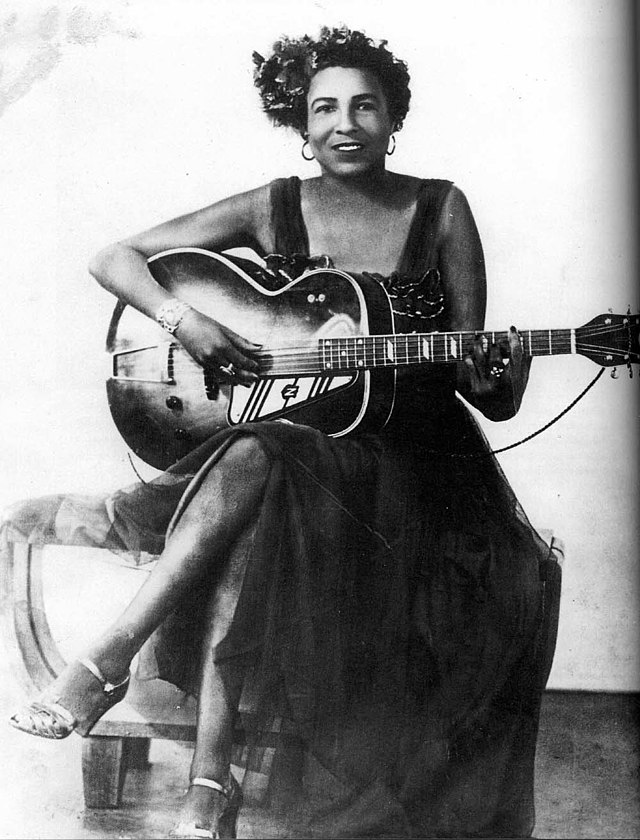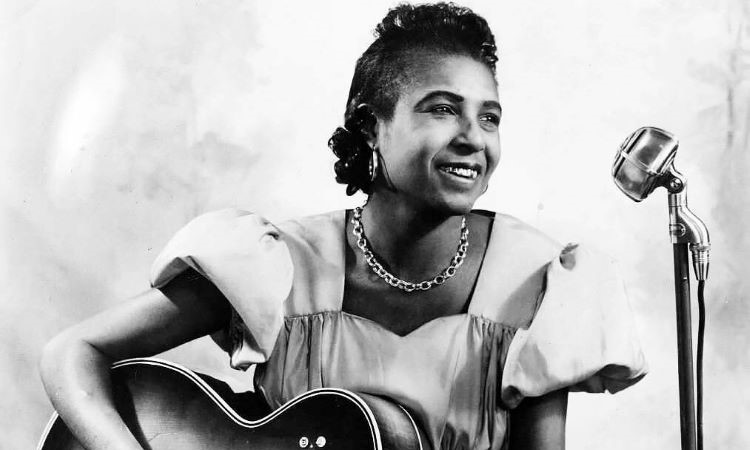Memphis Minnie – A Complete Biography
Introduction
Lizzie Douglas — known to the world as Memphis Minnie — was one of the most formidable and influential figures in early American blues. A singer, guitarist, and songwriter whose recording career stretched from the 1920s into the 1950s, Minnie combined technical skill on the guitar with a voice and persona that could be tender, tough, sly, and fiercely independent. She broke gender expectations in a male-dominated field, wrote and recorded songs that became standards, and left a legacy still felt by blues guitarists and singers today.

Childhood
Lizzie Douglas was born on June 3, 1897 (commonly cited), probably in Tunica County, Mississippi, though she sometimes gave New Orleans or the Algiers neighborhood as her birthplace in later retellings. She was the eldest of a large family; her parents were sharecroppers and the family moved during her early years to the area south of Memphis. From an early age Lizzie showed musical curiosity and talent. Family hardship, the demands of farm life, and the everyday music of Black communities along the Mississippi River shaped her earliest experiences with song and rhythm.
Music was woven into ordinary life for young Lizzie: church hymns, field hollers, string-band and guitar traditions, and the blues that circulated in the river towns. These sounds would form the raw materials of the style she later refined into a singular voice: a blues guitarist and singer equally at home in intimate porch settings and on busy urban streets.
Youth
As a teenager Lizzie ran away to Memphis and became part of the vibrant street-music culture around Beale Street. She earned money performing on corners and in small venues and, according to accounts, sometimes supplemented her income with work in brothels and odd jobs common to itinerant musicians of the era. She began using the nicknames “Kid Douglas” and later “Memphis Minnie” as her onstage identity took shape.
In the 1910s and into the early 1920s Minnie toured and worked with various shows, and reports indicate she spent time performing with traveling circuses and medicine shows — opportunities that exposed her to a wider repertoire and taught her how to command an audience. These early experiences forged both her technical facility on guitar and a highly self-aware stage presence: she knew how to make a song matter and how to project personality through phrasing, rhythm, and witty, sometimes risqué lyrics.
Adulthood and professional career
By the late 1920s Memphis Minnie was performing with established blues players and making an impression as a guitarist and singer who could match any male peer in skill and showmanship. In 1929 she recorded with Kansas Joe McCoy (who became one of her husbands) and took the stage name Memphis Minnie for her records. That same period marked the beginning of a prolific recording career: through the 1930s, ’40s, and into the early 1950s Minnie recorded for a variety of labels and under different billing arrangements — solo, with Kansas Joe, and later with her husband Ernest “Little Son Joe” Lawlars.
Her playing evolved through the years. Early recordings show a strong fingerpicking and bottleneck tradition; later work incorporated more composed arrangements and, after moving to Chicago and spending time in northern urban blues circles, touches that reflected the changing sound of the blues. Minnie’s professional life also included frequent live work — house parties, radio spots, and club dates — and she navigated the turbulence of the Depression and the shifting commercial music industry with a mixture of entrepreneurial savvy and toughness.
Her personal life was complicated as it often was for touring musicians. She married more than once (including brief marriage to Kansas Joe McCoy and later to Little Son Joe) and sometimes toured with, or performed alongside, partners who were also musicians. Those partnerships produced productive musical collaborations but could also bring jealousy and tensions. Despite these challenges she remained a steady creative force, writing and recording prolifically.
Major compositions (selected)
Memphis Minnie wrote and recorded roughly two hundred songs across a career that spanned decades. While she produced many pieces, several songs stand out for their influence, durability, and later reworkings by other artists:
- “When the Levee Breaks” (1929, with Kansas Joe McCoy) — An evocative early recording about flooding and loss that later inspired later generations of musicians; its lyrical and rhythmic power made it one of her best-known pairings.
- “Me and My Chauffeur Blues” — A swaggering, playful number that showcases her narrative songwriting and confident vocal delivery; it became a staple covered by many artists.
- “Bumble Bee” — A blues song with a call-and-response energy and memorable guitar lines; it demonstrates Minnie’s skill with catchy hooks and streetwise lyrics.
- “Nothing in Rambling” — A contemplative piece that captures the loneliness and restlessness of a life on the road.
- “Baby, Please Don’t Go” (early versions and compositions in the same vein) — While versions of this title circulated widely in blues traditions, Minnie’s recordings and interpretations contributed to the song’s broader circulation.
Her songs often blend humor, sexual frankness, worldly observation, and plainspoken wisdom. As both guitarist and singer she was equally responsible for the arrangements: guitar motifs that supported the story being sung, and rhythmic figures that helped the vocal line land with punch.
Later years and death
After World War II public taste and the record industry’s focus shifted, and like many prewar blues artists Minnie’s recording opportunities dwindled. She continued to perform locally and occasionally record into the early 1950s, but health problems began to interfere with her ability to work. She and Little Son Joe eventually retired to Memphis.
In 1960 Minnie suffered a stroke that left her partially incapacitated, and she endured further health setbacks later on. Artists, fans, and sympathetic readers rallied at times to assist; periodicals and blues enthusiasts drew attention to her situation, but the later years were marked by physical decline and reduced public presence. Lizzie “Memphis Minnie” Douglas died of a stroke on August 6, 1973, in Memphis, Tennessee. She was buried in Mississippi.
Conclusion
Memphis Minnie’s life is a portrait of resilience, craft, and artistry. She moved from rural Mississippi and the river towns to the busiest blues streets of Memphis and beyond, carved out a reputation as a guitar virtuoso and a strong, exacting vocalist, and composed songs that entered the blues canon. Her influence extends not only through the artists who covered her songs but through the generations of women guitarists and singers who followed in her wake — musicians who could look to Minnie as proof that blues skill and authority were not limited by gender.
Though time and the shifting priorities of the music industry diminished her commercial profile late in life, historical reassessment has restored Minnie to her place among the great early blues innovators. Her recordings remain vital documents of an era and a style, and her voice — muscular, sly, and true — still speaks to listeners who want the blues that confronts life with clarity and wit.

Comments are closed